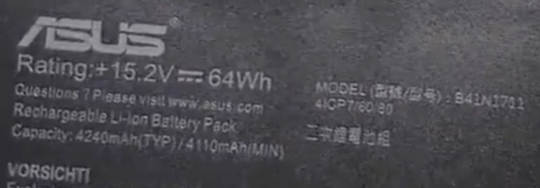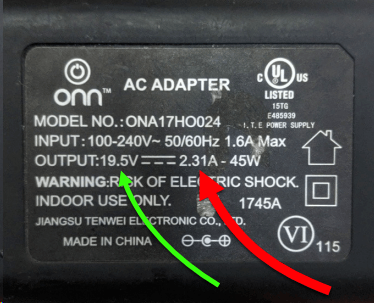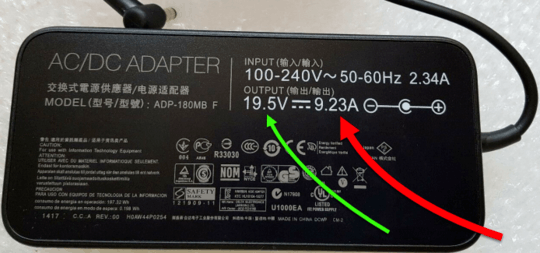An EE here. Your power supply is inadequate to power the laptop. Since this model has a non-removable battery, your best bet is to attempt powering it using a properly rated supply. Any other testing would be inconclusive.
A bit more details, if you want to understand how parts of the puzzle connect here. First of all, suppose the laptop is totally off, and you are trying to charge the battery alone. In this disassembly video at 3:07 the rating of the battery can be clearly seen:

Model B41N1711, nominal voltage 15.2V, capacity (typical) 4240mAh.
A typical Li-ion battery charger (the battery is marked generic Li-ion, but judging by its thin rectangular cells, it's most likely a Li-polymer type; this is not really important) works in 3 different modes. To explain them, let's use C for the battery capacity divided by 1 hour: C=4.3A (rounding up to 2 digits). This parameter is important, as it is used as the maximum charging current for the battery.
The battery appears to contain 4 cells, ostensibly used in series, as the per-cell voltage of 15.2V/4=3.8V is in a typical range for a Li-ion cell. This is important, as we base the threshold on a per-cell voltage (and current through all 4 cells is the same, as they are connected in series. Actual picture is much more complex, but this is not essential for understanding, except why I am talking about voltages as small as 3V: that's a per-cell voltage).
When the battery is deeply discharged, the charging circuit supplies a constant current of 0.1×C, which is only 0.43A, something that your supply is perfectly capable of. This is the first mode. It is important to limit the charge current at this stage, because if you connect the cell to (an ideal) voltage source, it will consume tens of times more than C, and likely explode from overheating.
When the battery is conditioned enough so that per-cell voltage reaches ~3V, the charger is safe to switch to the full charge current mode (but still a constant current!), so that it switches to supplying the full C, which is 4.3A. Your supply is rated for only half of this current.
Now, for the sake of completeness, I should mention the third mode, the constant voltage charging. Normally, the charging circuit would switch to this mode when the per-cell voltage reaches some 0.3V above the rated voltage, which would be 3.8+0.3=4.1V per cell. The battery took enough charge so we know it wont gulp too much current and explode, and now we feed the cell voltage, and measure charging current. Note it was the other way round until now. When the current naturally drops to 0.1×C, the charging circuit is turned off, as the battery is now considered fully charged.
What happens if the charger is trying to feed 4.3A into the battery, but your supply is rated for 2.3A? This depends on how much self-protecting circuitry is there in the supply. A quality power supply will turn itself off for a time, and attempt to restart in a few seconds. A cheap supply will experience a voltage sag (well below its rated output), and more likely than not overheat and die, either quietly or letting its magic smoke out. Some supplies have as simple a thing inside as a sacrificial fuse which melts when the current draw is too high.
What I think happened in your case. The charging circuitry inside the laptop is usually much smarter than that in a cheap power supply, because an error there can result in an explosion, fire, injury, death and/or a huge class action settlement. When it switched from the 0.1C to C constant current mode, the supply either turned itself off (if it's smarter) or simply sagged (if not). In either case, the charger detected an anomaly and stopped charging the battery. After a short while, it attempted a restart. Again, it starts gently at 0.1C, measures the voltage (after a couple seconds, to let the chemistry settle), and, detecting the 3V threshold voltage, switches to full C current mode... rinse, repeat. You've got the on-off charge cycle, and the 20s cycle time does not look implausible, although it seems nearly too long a time.
The notebook does not always consume 180W! Imagine putting a 200W incandescent bulb into this case: it would be quite hot. The actual power consumption is much less, at least until you load both the CPU and GPU to full capacity and turn screen backlight to eleven, while simultaneously charging the battery at the maximum current--and still the rating is usually given with a large margin. So, when doing almost nothing, even a powered laptop would discharge the battery very gently while our cycle of overloading the supply and turning off the charger continued (2.3A seems just enough to power the idle laptop at ~20W and send 0.1C to the battery). This would just lengthen the time it takes the charging circuit to charge the battery to that threshold of 3V by an extra 10-15 seconds (because the powered laptop would discharge it a bit while supply is not powering the whole rig) does not seem unlikely. Now the period of 20s makes even more sense.
TL;DR: Your power supply is likely toast, and is no match to the load anyway. Maintaining the battery at below 10%¹ capacity is not optimal, but it is not likely to hurt it much, and it is probably still good. Borrow an adequate known good power supply, and try to boot the laptop.
Then, if it boots, but the battery does not charge, let it charge for a while (the laptop does not have to be on, just plugged in). If the battery has deeply discharged from just sitting there unpowered, it may take from hours to few days to recover, and then at some moment you'll notice it would take the charge normally. If it does not start charging after 3 days, well, shop for a new battery and have someone qualified replace it. Do not try it yourself if you do not know what you are doing, and do not think that you know what you are doing if you've seen someone doing it on YouTube! A lithium battery is literally an incendiary device if handled improperly, and a flat cell case is made of just thick foil, too easy to puncture and short at the same time.
If the machine does not boot, or at least shows any signs of life with a known good power supply, then please recycle it responsibly, sorry. :(
¹ This article on DigiKey mentions the preconditioning charge of 10% in the first paragraph under the “Carefully does it” heading; the full, 100% charge is the total area under the “battery current” line on the graph, and the preconditioning charge at 0.1C is the area under the part of the line from time 0 to the point where the charge current jumps from 0.1C to C. Since the battery sat idle for a while, it may have discharged completely through its natural leakage.
(Thanks to @MrEthernet for the request to clarify the original value of 20% for the initial low-current preconditioning phase; the value was, according to the op. cit., incorrect, and I updated it.)



What output voltage and current does the adapter you used say it provides? – Mr Ethernet – 2019-10-22T21:28:29.707
8Buy the proper ac adapter, i doubt the laptop is damaged but the adapter is. – Moab – 2019-10-22T21:50:42.893
37Yup. 180W / 45W = 4. The AC adapter died a toasty death trying to provide 4x more power than it was ever designed to to a very power-hungry laptop. – Mr Ethernet – 2019-10-22T21:58:16.317
@Mr Ethernet The adapter that i used says Output: 19.5V --- 2.31A - 45W, i'm not sure what that means, but i hope that's the answer for the question – Kakuhiry – 2019-10-22T22:04:55.143
1@Moab Yeah, that's what i'm thinking of doing, but i'm super short on money, i may start my first ever job next week, i may buy it then – Kakuhiry – 2019-10-22T22:05:55.720
Is it definitely the laptop that's dead? It's possible the laptop just ran out of battery and the charger is dead - which is more likely than usual given it's undersized. – Simon – 2019-10-23T07:33:37.413
3If the battery is toast because of old age the laptop will try to run essentially on the adapter which is too small to power it. – Peter - Reinstate Monica – 2019-10-23T14:32:03.347
1Despite all the answers saying the power supply is dead, I don't think we have enough information to say so for sure. It's likely it's the power supply, but it could be a component inside the laptop as well. Unless you test the laptop with a known good power supply (or the power supply with a known good laptop), it's nearly impossible to tell. If you have a multimeter you could also check if there's any voltage on the power supply connector (the one on the laptop side, of course). – jcaron – 2019-10-23T15:44:58.993
1@Mr Ethernet: 180 W would be the maximum the laptop would draw, with all CPU(s), cooling fans, hard drives, and other accessories running. If the machine is just sitting idle, it will draw much less - for instance, I'm just running FireFox and normal Linux background processes now/ CPU is around 3%, fan is off, and (per PowerTop) I draw about 18W. Likewise, if you leave the machine off and the charget plugged in, your battery should charge, and would then power the machine until it is drained. – jamesqf – 2019-10-24T03:33:02.997
9@MrEthernet Is this based on actual EE knowledge or are you just making a guess here? I don't think that a properly designed power supply with current limiting would "die a toasty death" because it's only going to supply it's rated power regardless of how much the load is trying to draw. If you plug a phone capable of charging from 2A into a 500mA computer USB port the computer won't catch fire, it will just charge the phone 4 times slower. As far as I can tell the only problems that would arise from using a properly designed 45W charger would be slower charge times. – JShorthouse – 2019-10-24T11:56:14.267
2
@JShorthouse "...are you just making a guess here?" Do some research into the OP's replacement adapter. This isn't a "properly designed power supply with current limiting". It's a budget $20 charger from Walmart, with multiple customer complaints of overheating. https://www.walmart.com/ip/Onn-Universal-45W-Laptop-Power-Adapter-Charger/540687592
– Mr Ethernet – 2019-10-24T12:00:46.190@MrEthernet Alright, well that's a separate problem entirely then and would happen with a 45W laptop too. It has nothing to do with "trying to provide 4x more power" - that's not how power supplies work. – JShorthouse – 2019-10-24T16:45:33.110
1@JShorthouse "the computer won't catch fire" I never said anything would catch fire. You're critizing me for assuming that a cheap $20 adapter doesn't have a current-limiting circuit, before assuming yourself that it does. Neither of us knows for sure but we do know that something failed here. I'm not sure what point you're trying to make to be honest. What are you trying to suggest? That it's the laptop failed and not the adapter? Or that the adapter failed but it's a coincidence and had nothing to do with the excessive demand placed upon it? – Mr Ethernet – 2019-10-24T17:33:07.887
@JShorthouse "... Otherwise, if the power supply provides the excess current beyond its rated amount for a prolonged time, it may damage the components." https://www.sunpower-uk.com/glossary/what-is-rated-output-current/ You can find plenty of references to power supplies being irreparably harmed by prolonged excessive current demands if you do some research. This often is "how (some) power supplies work", particularly no-frills $20 budget models. "actual EE knowledge" the question here is does the adapter have a current-limiting circuit or not. We don't know for sure, but it failed.
– Mr Ethernet – 2019-10-24T17:41:51.000Current limiting circuitry costs money. It's quite likely that a cheap adapter will lack this, and the current draw will exceed its capacity, it will overheat and possibly melt. – Stabledog – 2019-10-24T19:03:22.823
2@MrEthernet Your original comment is extremely misleading and it seems like people upvoting it don't understand how power supplies work. It gives off the impression that an ideal 45W power supply connected to a 180W load will just attempt to supply 4x it's rated current and die, when that isn't how power supplies should work at all. You've found the right reasons now but I don't genuinely believe that's what you were trying to convey in your initial comment. – JShorthouse – 2019-10-24T20:24:51.613
1@JShorthouse "You've found the right reasons now" In the interest of brevity and due to comment character limitations, I didn't go down the rabbit hole of discussing possible unknowns ad nauseam in my initial comment. That's not what comments are for. You're assuming that a $20 Walmart adapter will have a particular feature. Common sense suggests that feature is lacking here because the adapter apparently couldn't protect itself from damage caused by prolonged overloading. It could be a coincidence but it's more likely it worked too hard. Either way, I think we both essentially agree! – Mr Ethernet – 2019-10-24T20:40:31.010
1@MrEthernet "I think we both essentially agree" Yes :) I hope you will agree with me that your initial comment is somewhat misleading though, obviously you seem to understand the "real" reasoning but from your comment I think that a layman would deduce that a power supply is perhaps like a shelf rated for 45Kg that will collapse when 180Kg is loaded onto it. Obviously for an ideal power supply this would not be the case, and I think you should have mentioned current limiting in your comment, it would have still fit in the character limit :) – JShorthouse – 2019-10-24T20:56:49.070
@JShorthouse The USB example is misguided. Phones use special tricks to determine the capabilities of the power supply they're connected to (e.g., the presence of particular voltages on the data lines). It is the phone that is limiting the current, not the power supply. "actual EE knowledge" is that if you connect a 45W charger to a 180W laptop it may be damaged because you're using it outside its rated specifications, very much like the shelf you're referring to which may collapse when overloaded. – Tom van der Zanden – 2019-10-25T10:30:25.350
1@JShorthouse Is your comment based on "actual EE knowledge"? Because it sure doesn't look like it is. Current limiting needs to be actively added to a power supply circuit, it doesn't just come for free, and the vast majority of cheap power supplies don't have it. The phone example is wrong because it's the phone that's limiting the amount of power it draws to avoid killing older USB ports (and shitty unprotected chargers). Power delivery negotiation is a relatively new technology that is basically limited to usb devices, there's no reason to do it between a pc and its own dedicated charger. – Demonblack – 2019-10-25T12:51:16.587
@JShorthouse In EE there are no "ideal 45W power supplies." There are ideal 19.5V voltage sources, and practical implementations of them may or may not have a maximum power rating of 45W. – user253751 – 2019-10-25T18:16:41.620